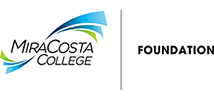ROLES AND RESPONSIBILITIES OF BOARD MEMBERS
The Foundation Board of Directors is the active governing body of the MiraCosta College Foundation. The board’s role is to approve and implement the foundation’s mission, providing financial oversight and fundraising for the foundation in support of the college's mission, vision, commitment, values and goals.
Foundation board members are ambassadors and champion the foundation’s mission to promote the benefits of MiraCosta College and secure resources that transform lives through education through our top five board responsibilities:
Give Generously: Make a personal gift of $1,000 or more to the Annual Fund, which includes membership in the President’s Circle. 100% board giving makes a powerful statement to individuals, companies, and institutions being asked to support MiraCosta College Foundation.
Help Us Raise $150,000 - $250,000 Annually: Give and help secure gifts for appeals, matching gift campaigns, event sponsorships, and naming opportunities. (Estimated time commitment included below.)
Open Doors: Engage new donors through introductions and stewardship. Board members promote MiraCosta College to friends, family, and colleagues who might support the college financially. Board members are ambassadors; they know the college story, tell it, and sell it. (Estimated time commitment: 1-5 hours per quarter, depending on the engagement opportunities selected by board members.)
- Invite and bring guests to an event, campus tour, or coffee meeting
- Identify speaking engagements (for example, at Rotary or service clubs)
- Host and sponsor a foundation event (such as a President’s Circle event) alongside the staff team at home or business.
Be Present: Board members attend in-person meetings, a minimum of three out of four board meetings per year, and participate in two committees. Board members attend and support key foundation and college events: at least two college events and one foundation event per year. (Estimated in-person time commitment: 4 hours per quarter plus drive time. In addition, estimated virtual time commitment: 1-2 hours per quarter.)
Engage Fully: In the first meeting of our fiscal year, members complete the Board Member Engagement Plan in August to set our annual commitment. Board members are actively involved in governing the foundation including monitoring and approving foundation policies and procedures, reviewing and approving the annual budget, and providing financial oversight.
Leadership
To uphold the experience of each MiraCosta College Foundation Board member while ensuring the board operates to its full capacity, it is essential that the roles of all key players are clearly defined. The college defines the role of the College Superintendent/President and the Vice President of Institutional Advancement (VP). Board members shape their roles and set expectations of fellow board members that create a productive and positive volunteer experience. This self-governance is led by the Board President.
Role of the Foundation's Board President
The Board President is a full partner with the College President and the Vice President. The collaboration between these three roles sets up the structure needed for the board members to fully participate.
- Coordination. Touching base regularly with committee chairs to coordinate and monitor committee activities.
- Communication. Communicating with the President and VP; keeping informed of committee activity; and touching base regularly with board members.
- Leadership. Modeling leadership behavior. The Board President sets the standard for philanthropic participation and in the college’s fundraising events and efforts.
Role of the College Superintendent/President
The Superintendent/President’s role is the key in establishing the credibility of the board as the institution’s senior volunteer organization.
- Leadership. Providing leadership for the board, raising the visibility of the foundation and its benefits in the community at large as well as the campus community.
- Inner Circle. Sharing college information with the “inner circle.” The Superintendent/President is expected to keep the board abreast of the latest developments throughout the district.
- Working Culture. Building a working culture for the board. By example, the Superintendent/President leads the board in its fundraising work, and is a full partner in the process of donor identification, cultivation, and solicitation.
Role of the Vice President of Advancement
The role of the Vice President of Institutional Advancement (Vice President) is to design, develop, and implement strategic plans for the organization in a cost-effective and time-efficient manner. The Vice President is also responsible for the day-to-day operation of the foundation, including managing staff and developing business plans. The Vice President is accountable to the College Superintendent/President and provides quarterly progress reports to the Foundation Board. Board members are invited to offer suggestions and ideas about how to improve the organization, and the Vice President decides whether and how to implement these ideas.
- Leadership. Is visionary, providing leadership in fundraising strategies and programs and is flexible and responsive.
- Communication. Providing timely communications to board members regarding college plans and development program progress in meeting strategic and tactical goals.
- Board Development. Developing and nurturing the existing talents of the board members, participating in the identification of potential members, and connecting board members with service opportunities.
- Fundraising and Administrative Expertise. Staying on the cutting edge of the profession through continuous professional development.
**Learn more about Brown Act Compliance Requirements.

